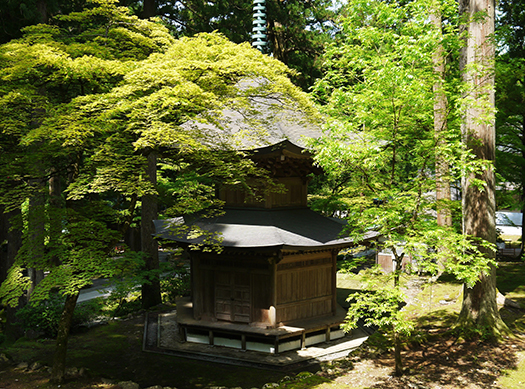

さて永平寺探訪シリーズを全15回にわたって書き続けてみました。
たぶん総文字数は20,000字以上に上っている。
400字詰め原稿用紙(古っ!)換算すると50枚くらいの原稿量。
これくらいひとつのテーマで集中すると面白い掘り起こしができる。
建築的にも人物的にもいろいろな側面がみえてきて自分でも楽しい。
そのなかでも修行僧たちが生涯で2度しか通れないという山門が印象的。
山門をくぐるに際しての掟書にとくに惹かれた。
「どんな社会的地位の者でも仏を求める心が無ければ門より入ることは許さない」
「そうであるが、山門は鍵はかからず扉もない、入り口は常に解き放れている、
善財童子の道心があればいつでも入ることができる」
この「善財童子」という部分に永平寺の存在感が集約されているように思う。
よき宝物であるこどものまっすぐなこころというように読み下せる。
写真は寺域に建てられている「少年道元の像」。
道元の少年時の像がなぜいくつか作られたかのモチーフとして
こうした道元の宗教への姿勢が多くのひとのこころを打ったのではないか。
いつの日か、まっすぐに禅修行に向かう童子が永平寺を目指してくることを
この像は願っているように思われるのです。
輪廻転生ということは「信じるこころ」の基底にあるように思うけれど、
凜としてまっすぐ前を見つめる像の姿には力がある。


日本人のDNAには仏教を信じた多くの人のこころが宿っているのではないか。
感染症の猛威の中で、ゆれ動く社会の実相を見つめながら、
こんな想念が立ち上ってくるように思います。
歴史記録でははじめて「都市」を造成したと思える奈良の都で
本格的なパンデミックとして天然痘が猛威をふるったとき、
鎮護国家思想を領導した天皇聖武の皇后、光明子は
おおみたから・民びとの平癒を祈願して「蒸し風呂」公衆浴場を創始した。
宗教とパンデミックは歴史の中でいつも相互に影響し合ったのではないか。
日本人は地べたの土間床空間の住宅から徐々に床上げされた住宅に移行し
汚濁した土間から「靴脱ぎ」した生活空間に移行した。
清浄を心がける生活空間を獲得していったことは、
繰り返されたパンデミックからの民族の知恵のように思えてならない。
その上、手洗い習慣までも暮らしレベルで日本人は機能獲得してきた。
上の写真は道元が宋から帰国した際、海が荒れたときに
ほとけの化身が舟に乗って現れて道元の道行きを守護したという像。
下は信者から奉納された写経を納める納経塔。
ちょっと長くなったので最後は少年・道元さんとお別れを言いたくなった(笑)。
またいつか、永平寺再訪してみたいです。
English version⬇
[Farewell to the dignified boy Dogen-san for a while, Eiheiji-15]
Well, I continued to write the Eiheiji exploration series 15 times in total.
Perhaps the total number of characters is over 20,000.
The amount of manuscript is about 50 when converted to 400-character manuscript paper (old!).
If you concentrate on one theme like this, you can do interesting digging.
I can see various aspects both architecturally and personally, and it's fun for me.
Among them, the Sanmon, where the monks can only go twice in their lifetime, is impressive.
I was particularly attracted to the rules when passing through the Sanmon.
"Anyone in any social status will not be allowed to enter through the gate without a desire for the Buddha."
"Yes, but the gate is unlocked and has no door, the entrance is always unleashed,
You can enter anytime if you have the spirit of a good-fortune child. "
I think that the presence of Eiheiji is concentrated in this "Sudhana" part.
It can be read as a straight heart of a child who is a good treasure.
The photo is the "Shonen Dogen Statue" built in the temple area.
As a motif of why some Dogen boyhood statues were made
Dogen's attitude toward religion may have hit many people's hearts.
One day, I hope that a child who goes straight to Zen training will head for Eiheiji Temple.
This statue seems to be hoping.
I think that reincarnation is the basis of the heart that people "believe".
The appearance of the statue looking straight ahead as a dignity is powerful.
The DNA of the Japanese may contain the hearts of many who believed in Buddhism.
While gazing at the reality of a swaying society in the midst of infectious diseases
I think that such an idea will come up.
In the capital of Nara, which seems to have created the "city" for the first time in historical records
When smallpox raged as a full-fledged pandemic
Empress Komyō, the empress of Emperor Shomu, who led the idea of the guardian state
She founded a "steam bath" public bath to pray for the healing of the people.
Religions and pandemics have always influenced each other in history.
The Japanese are gradually shifting from houses with a ground floor space to houses with raised floors.
We moved from the polluted dirt floor to a living space where we "take off our shoes".
Acquiring a living space that keeps cleanliness in mind
It must not seem like ethnic wisdom from repeated pandemics.
Moreover, even the habit of washing hands has acquired functions at the living level.
The photo above is when Dogen returned from Song and the sea was rough.
A statue in which an incarnation of Hotoke appeared on a boat and protected Dogen's way.
Below is the sutra-copying tower that houses the sutras dedicated by the believers.
It's been a little long, so at the end I wanted to say goodbye to the boy, Dogen-san (laughs).
I would like to visit Eiheiji Temple again someday.



















